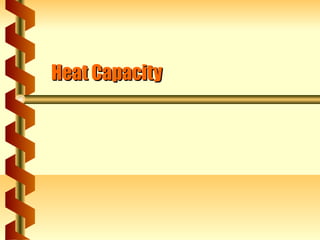
P210 13b
- 2. Work In Work done The work - energy principle on a system applies to all objects. v1 v2 • If an object speeds up it gains kinetic energy. K1 = (1 / 2)mv12 K 2 = (1 / 2)mv2 2 • If an object slows down it loses kinetic energy. ∆W = ∆K
- 3. Heat In Heat into a Temperature change is due system to heat (Q). • If an object’s temperature increases it gains heat. T1 ,U1 T2 ,U 2 • If an object’s temperature decreases it loses heat. ∆Q ∝ ∆T
- 4. Heat Capacity The ratio of the change in heat to the change in temperature is the heat capacity (C). • Depends on material • Depends on the mass • Measured in J/K ∆Q = C∆ T
- 5. Specific Heat The ratio of the change in Material Specific heat heat to the change in Mercury 140 J/kg-K temperature is the heat Copper 390 J/kg-K capacity (C). Steel 500 J/kg-K • Depends on material • independent of the mass Granite 840 J/kg-K • Measured in J/kg-K Aluminum 900 J/kg-K Wood 1400 J/kg-K Ice 2100 J/kg-K ∆Q = mc∆T Water 4200 J/kg-K
- 6. Take a Shower You are last to use the Find the heat required. shower today and the ∆Q = mc∆T = (150 kg) temperature in the water (4200 J/kg-K) ( 32 C) heater has dropped to 18 °C ∆Q = 2.1 x 107 J from the normal temperature of 50 °C. The heater holds Find the time from the 150 kg and has a 50 kW power, and set the heat to heating coil. the work. P = ∆W/∆t How long should you wait t = ∆Q / P before starting your shower? (2.1 x 107 J) / (5 x 104 W) t = 4000 s = 1.1 hr
- 7. Equilibrium Temperature Two systems in thermal contact will adjust to reach the same temperature - thermal equilibrium If they are thermally insulated, all the heat goes from the hot system to the cold system. 1 2 m1c1∆T1 + m2 c2 ∆T2 = 0
- 8. Doing Dishes A 1.5 kg aluminum pan is Setup the equation for an heated to 180 °C then unknown equilibrium placed into a sink with 8 kg temperature T. water at 20 °C. m p c p (T − Tp ) + mwcw (Tw − T ) = 0 If no water boils, what is the Solve for T. equilibrium temperature? m p c pTp + mwcwTw T= m p c p + mwcw T = 26 °C next